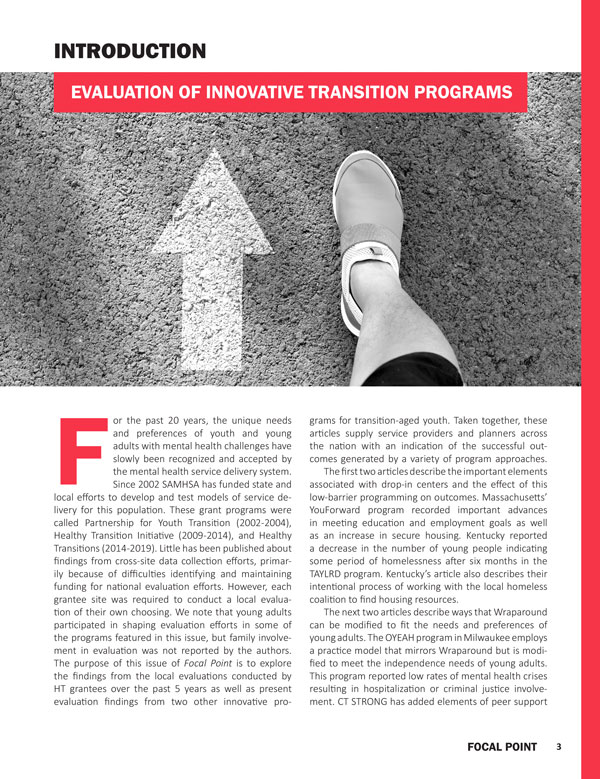
Abstract: This introduction provides an overview of the outcomes attained through the Healthy Transitions programs discussed in the 2019 issue of "Focal Point."
"Introduction: Evaluation of Innovative Transition Programs" (2019)
By Nancy Koroloff & Eileen M. Brennan
For the past 20 years, the unique needs and preferences of youth and young adults with mental health challenges have slowly been recognized and accepted by the mental health service delivery system. Since 2002 SAMHSA has funded state and local efforts to develop and test models of service delivery for this population. These grant programs were called Partnership for Youth Transition (2002–2004), Healthy Transition Initiative (2009–2014), and Healthy Transitions (2014–2019). Little has been published about findings from cross-site data collection efforts, primarily because of difficulties identifying and maintaining funding for national evaluation efforts. However, each grantee site was required to conduct a local evaluation of their own choosing. We note that young adults participated in shaping evaluation efforts in some of the programs featured in this issue, but family involvement in evaluation was not reported by the authors. The purpose of this issue of Focal Point is to explore the findings from the local evaluations conducted by HT grantees over the past five years as well as present evaluation findings from two other innovative programs for transition-aged youth. Taken together, these articles supply service providers and planners across the nation with an indication of the successful outcomes generated by a variety of program approaches.
The first two articles describe the important elements associated with drop-in centers and the effect of this low-barrier programming on outcomes. Massachusetts' YouForward program recorded important advances in meeting education and employment goals as well as an increase in secure housing. Kentucky reported a decrease in the number of young people indicating some period of homelessness after six months in the TAYLRD program. Kentucky's article also describes their intentional process of working with the local homeless coalition to find housing resources.
The next two articles describe ways that Wraparound can be modified to fit the needs and preferences of young adults. The OYEAH program in Milwaukee employs a practice model that mirrors Wraparound but is modified to meet the independence needs of young adults. This program reported low rates of mental health crises resulting in hospitalization or criminal justice involvement. CT STRONG has added elements of peer support and family advocacy to their Wraparound process and demonstrated improvement in mental health symptoms, reductions in perceived stigma, and an increase in housing stability.
The following set of three articles focus on the population of young adults experiencing a first episode of psychosis (FEP). Delaware's CORE evaluation showed important differences in social connectedness for young people who had experienced a first episode of psychosis compared to those at clinical high risk for FEP. The Rhode Island Healthy Transitions project reported that after six months of services, young people with FEP indicated that they functioned better in social situations, found their symptoms less troubling, and felt more in control of their lives. The authors from Thresholds describe their approach to offering services for high-risk young adults while at the same time providing a coordinated specialty care team for young adults with FEP. Among other positive outcomes, a high proportion of Thresholds' MindStrong and Emerge Chicago-area participants enrolled in education or obtained employment after one year of services.
Each of the last three articles in this issue have a very specific focus. Wisconsin's YES! Program demonstrates how they have developed modified definitions for "positive outcomes" and "improved outcomes" and applied these to National Outcome Measures (NOMs) data. This allows them to report results that are more relevant to young adults' situations. Maryland's HT program provides in-depth academic supports that resulted in increased numbers of young adults engaged in education or training programs as well as a positive effect on their "perception of opportunity." The Florida Healthy Transition Team describes their peer-to-peer model and the employment of young adults in a variety of staff positions. They report several positive outcomes including a decrease in mental health symptoms.
The elements of each program's approach to providing services is only briefly described in each article due to space limitations. Readers may want to contact an article's authors for more details. Many thanks to all the authors who contributed to this issue of Focal Point.
Suggested Citation
Koroloff, N., & Brennan, E. M. (2019). Introduction: Evaluation of Innovative Transition Programs. Focal Point: Youth, Young Adults, and Mental Health, 33, 3–4. Portland, OR: Research and Training Center for Pathways to Positive Futures, Portland State University.